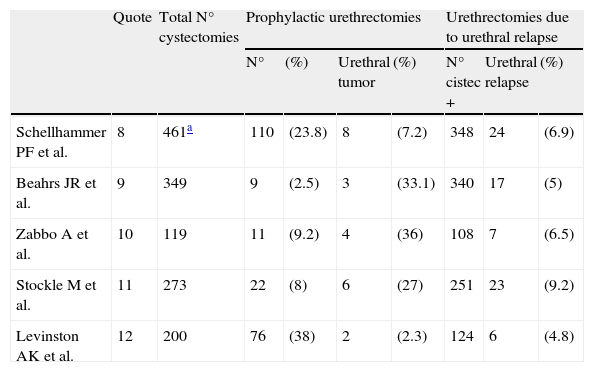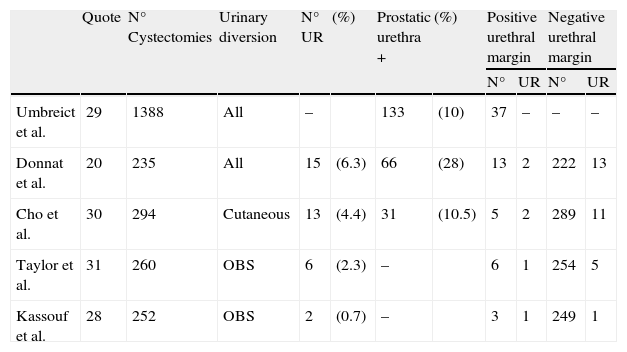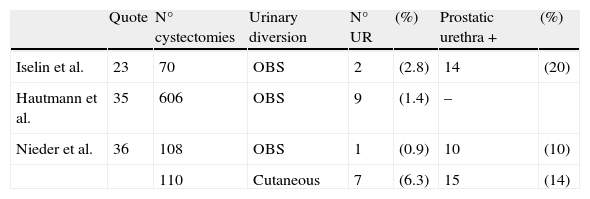Decision making regarding the urethra before and after radical cystectomy due to urothelial carcinoma has always been controversial.
ObjectiveTo analyze the changes produced in the management of the urethra from the beginning of the cystectomy up to the present moment.
Evidence acquisitionAnalysis of original articles and reviews obtained through a search in PubMed, related with the risk factors of urethral recurrence (UR) and with the management of the urethra in patients subjected to radical cystectomy.
Evidence synthesisAt first, many authors recommended urethrectomy simultaneously with cystectomy. The identification of risk factors of the bladder tumor related with the appearance of UR limited the indication of prophylactic urethrectomy in patients with multifocal disease and with prostate tumor involvement. The development of orthotopic bladder substitutes (OBS) complicated the situation. The involvement the prostatic urethral tumor was maintained as the principal risk factor for UR, which then gave importance to its pre-cystectomy staging. Series of OBS observed a lower incidence of UR regarding patients with skin derivations, even in cases with prostatic urethral involvement. Prostatic urethral involvement stopped being a contraindication for OBS when the frozen section biopsy of the urethral margin was negative.
ConclusionsCurrently, most authors agree that the intraoperative frozen section biopsy of the urethral margin will determine whether an OBS or urethrectomy should be performed. In spite of this, we have very few series in which this approach has been systematically used and with sufficient follow-up.
La toma de decisiones respecto a la uretra antes y durante la cistectomía radical por carcinoma urotelial siempre ha sido controvertida.
ObjetivoAnalizar los cambios producidos en el manejo de la uretra desde los inicios de la cistectomía hasta el momento actual.
Adquisición de evidenciaAnálisis de artículos originales y de revisión obtenidos mediante búsqueda en PubMed, relacionados con factores de riesgo de recidiva uretral (RU) y con el manejo de la uretra en pacientes sometidos a cistectomía radical.
Síntesis de evidenciaEn los inicios muchos autores recomendaban la uretrectomía de forma simultánea a la cistectomía. La identificación de factores de riesgo del tumor vesical relacionados con la aparición de RU limitó la indicación de uretrectomía profiláctica a pacientes con enfermedad multifocal y con afectación por tumor de la próstata. El desarrollo de las sustituciones vesicales ortotópicas (SVO) complicó la situación. La afectación por tumor de la uretra prostática se mantuvo como principal factor de riesgo de RU, lo que dio importancia entonces a su estadificación pre-cistectomía. Series de SVO objetivaron una menor incidencia de RU respecto a pacientes con derivación cutánea, incluso en casos con afectación de uretra prostática. La afectación de uretra prostática pasó a no ser contraindicación de SVO si la biopsia por congelación del margen uretral era negativa.
ConclusionesActualmente la mayoría de autores comparte que la biopsia intraoperatoria por congelación del margen uretral determinará si realizar una SVO o una uretrectomía. A pesar de ello disponemos de muy pocas series en las que esta actitud haya sido empleada sistemáticamente y con seguimiento suficiente.









